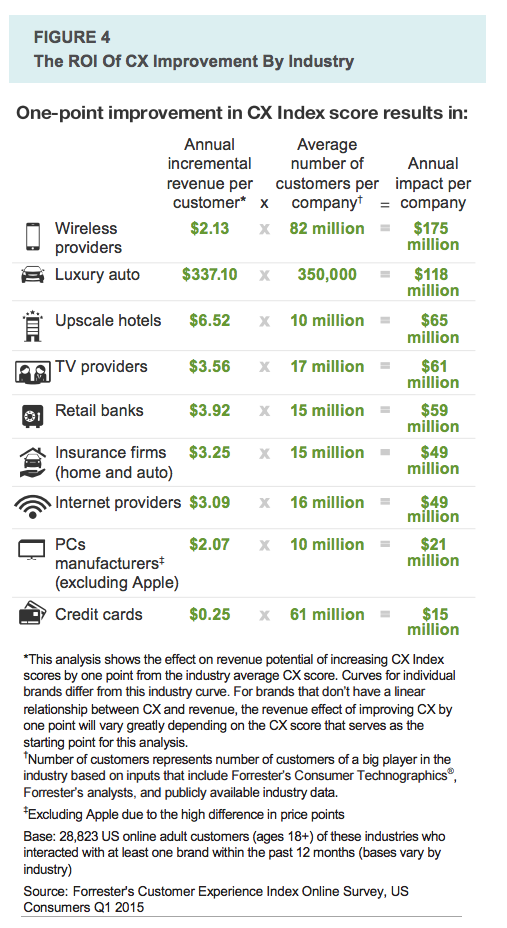
Photo credit: Pexels.
Within the first minute of entering a store, many things could make you decide to leave. You could be annoyed with the layout of the store, unhappy with the inability to find ready help, the dim lighting (or neon lighting, for that matter) within the store, put off by the cleanliness of the store, or just disappointed with the way the store does not feel inviting.
In short, the initial experience determines if a potential customer will become an actual paying customer.
In a study by Forrester and Accenture, a slight increase in customer experience (CX) scores can translate into a large increment of revenue. But only seven percent of companies are exceeding customers’ expectations of their digital CX. With digital becoming recognized as a legitimate new tool to improve customer experiences, not investing in digital CX can be dangerous.

The same study noted a group of CX high performers with different habits worth learning from.
Let data influence actions
CX high performers tend to have more sophisticated data and analytics practices, with 43 percent believing that their customer experiences are data driven. With the right digital tools, companies can tap into a wealth of data that help them understand their customer’s needs and behaviours.
Ecommerce heavyweights like Lazada often have a data science team mine for insights, helping them make decisions about how to enhance, streamline, and personalize the user experience from the browsing stage to the point of purchase. Such optimization will improve the journey, customer experience and obviously overall sales.
Data plays a critical role in logistics. Efficient management of data determines how quickly and affordably customers can get their products, a significant bulk of a shopper’s ecommerce experience.
“Customers’ expectations have dramatically risen, and people now expect 24-hour customer service, fast and cheap or free deliveries. It can be hard for ecommerce businesses to meet these time and price demands and stay profitable,” said Chang Wen Lai, CEO at Ninja Van.
To cope with these stress factors, many players like Ninja Van and Singpost often have a team of specialists dedicated to crafting computer algorithms to make decisions about driver deployments, delivery routes, and time.
Logistics also play a large role in the success of digital concierge services like Be Malas. Unlike most online stores, concierge services deal with much more uncertainty. To streamline the process, Be Malas keeps a database of partner merchants and past transactions to enable its team to automate decision-making.
According to Suthenesh Sugumaran, co-founder of Be Malas, big data also helps to anticipate and plan for demand.
Every time a new request is processed, a database of partner merchants and past transactions is mined to determine which merchants are the best fit, and what is the best delivery time and method to meet customers’ needs. These efforts towards personalization help to improve the overall experience of the shopper.
Better touchpoint impressions

Photo credit: Tookapic/Pexels
It is also important to ensure that the interface of customer touchpoints are optimized to improve experiences. For most ecommerce platforms, the website is the first impression that a shopper has. The website plays a significant role in earning customers’ trust. In a study, 94 percent of respondents directly related their feeling of mistrust towards a site to web design elements.
Airbnb is a classic example of how presentation can improve a platform’s success. After realizing that user-submitted photos were affecting the effectiveness of the listings, they rented a professional camera and went door to door to take photographs themselves. As a result, they saw an increase in bookings by two to three times and a doubling of Airbnb’s revenue by the end of the month.
Lazada also recently launched a new landing page reportedly intended to make relevant information more accessible to users.
For special events, such as the Great Singapore Sale (GSS), Lazada creates a landing page designed specifically for their customers as a differentiated way to manage a unique experience. The GSS page was interactive, mobile optimized, and featured deals and discounts exclusively for Lazada visitors. Lazada also created another dedicated landing page for its year-end sale, Online Revolution 2016.
Multiplatform

Photo credit: gregorylee / 123RF.
Traditionally, meeting customer expectations has been in full control of the businesses and the brands. Today, the fluid expectations have evolved to require businesses to meet customers wherever they are and when they are ready. To fulfill this, companies are experimenting with contextual commerce — bringing purchasing opportunities to shopper’s natural environments — and embracing cross-channel customer experiences.
One great example is TacoBell. TacoBell launched a chatbot on messaging tool Slack to reach out to the working crowd. The tool is still in private beta but gives us a glimpse of how food establishments are experimenting on the web.
Integrating customer experiences across platforms ensures that the brand can meet and respond to customers’ needs quickly. The rise of chatbots does just that — bringing the business to social apps in a way that is familiar, approachable and interactive.
Ninja Van adopts this approach by integrating mobile into their delivery process. Failed deliveries can be rescheduled with a two-click process through an SMS system, and their new Ninja Collect system helps customers reroute missed deliveries to a location convenient for them. When customers collect parcels from automated parcel lockers and retail partner stores, they do so with a verification code sent to them through mobile.
However, research shows that although businesses recognize the need to embrace cross-channel experiences, not everyone understands or takes this change seriously. As many as 99 percent of companies interviewed acknowledge the importance of integrating cross-channel experiences and only 45 percent of businesses are taking actions to improve. In fact, half of the companies surveyed are not even considering customers’ opinions in the process of improving their customer experience.
Planning for the future
While improving individual touchpoints will always be important, improving CX in ecommerce should not be conducted as an isolated project.
“Most customers weren’t fed up with any one phone call, field visit, or other interaction — in fact, they didn’t much care about those singular touchpoints. What reduced satisfaction was something few companies manage — cumulative experiences across multiple touchpoints and in multiple channels over time,” says experts from McKinsey.
For this reason, it is important for companies to adopt a state of constant flux when it comes to dealing with CX. In truth, only 20 percent of the respondents in the Forrester study believe that digital transformation is an ongoing initiative, while 72 percent expected to be done with their digital transformation in four years or less.
Customer expectations are evolving as fast as technology, and not incorporating agility and a culture of experimentation can make or break your business. Equally important, make sure you think customer experience ahead of making investments in new technologies.
Accenture Interactive helps the world’s leading brands delight their customers and drive superior marketing performance across the full multichannel customer experience. As part of Accenture Digital, Accenture Interactive works with over 28,000 Accenture professionals dedicated to serving marketing and digital clients, to offer integrated, industrialized and industry-driven digital transformation and marketing services. Follow @AccentureSocial or visit accenture.com/interactive.
This post Here’s how big companies like Lazada, Ninja Van are tackling customer experience in ecommerce appeared first on Tech in Asia.
from Tech in Asia https://www.techinasia.com/heres-big-companies-lazada-ninja-van-tackling-customer-experience-ecommerce
via IFTTT
No comments:
Post a Comment